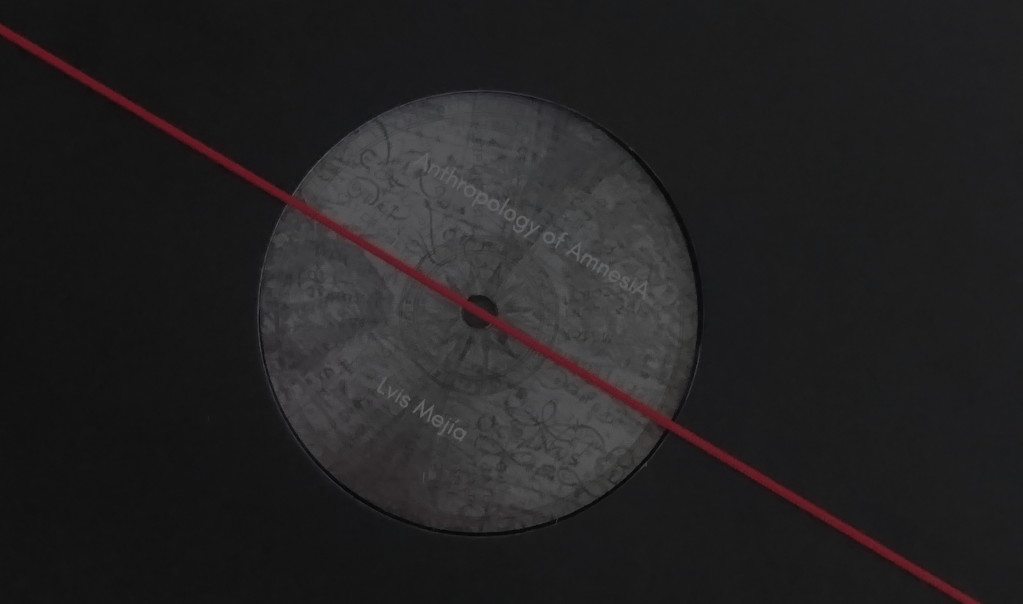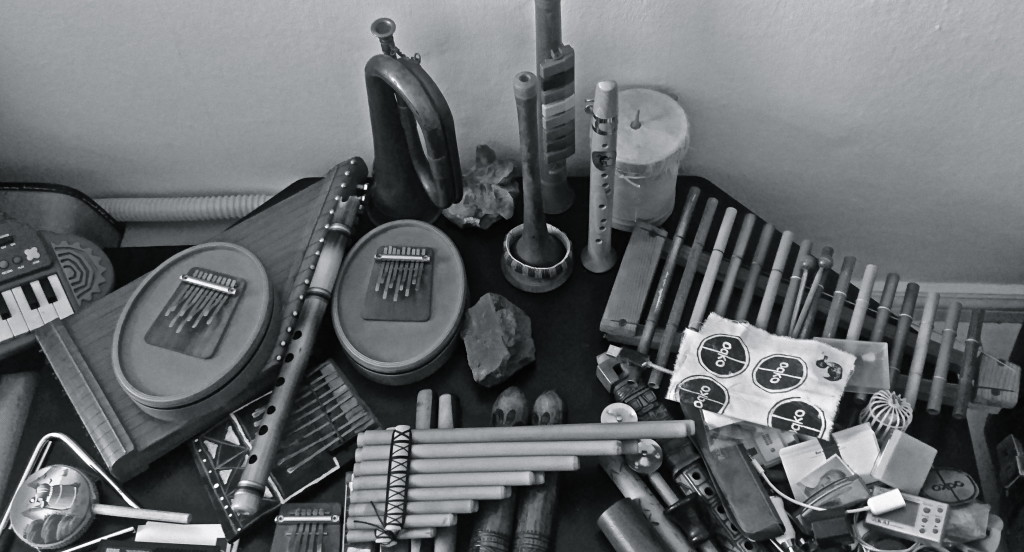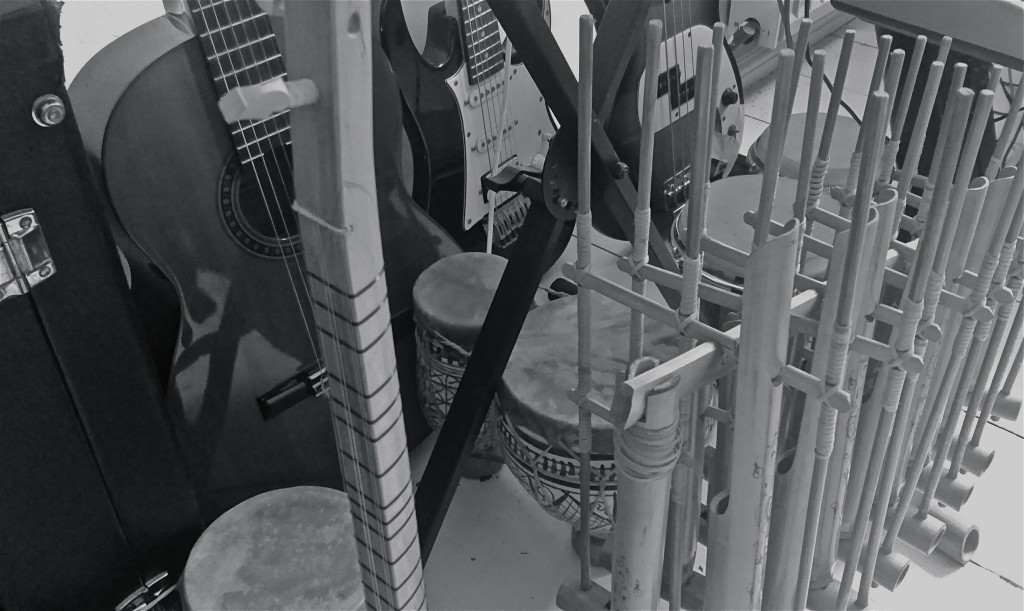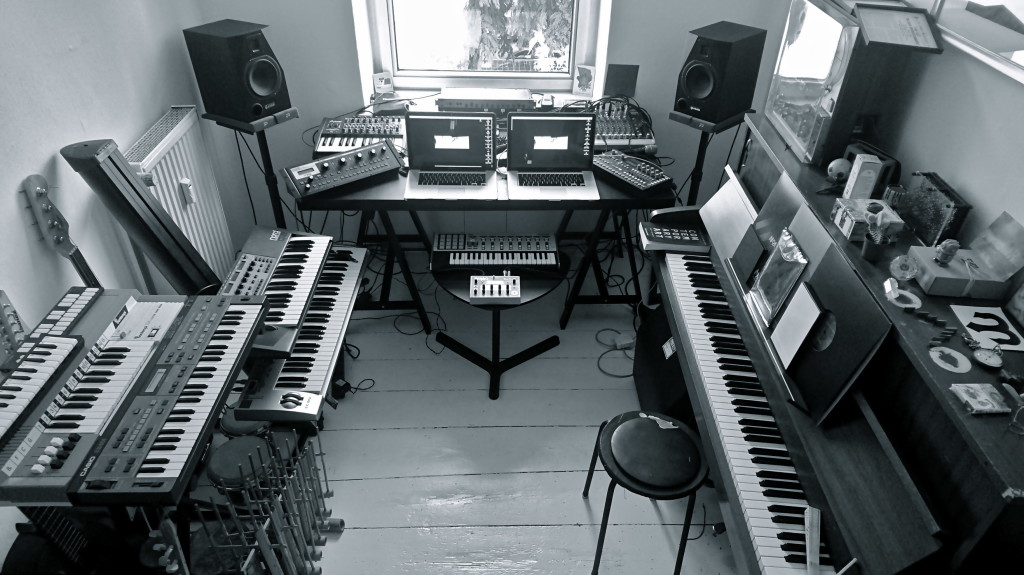In Mexican artist Lvis Mejía’s imagination, the ritual of sound blinks from Peruvian shamans to the Berlin zoo. We talked to him about his new work. It’s an experience of shared culture, collective unconscious – and a tale of assembling a career and collective between Mexico and Europe.
Born in Mexico but with his career emerging in the European art scene, Mejía is now a known name from appearances at Centre Pompidou, MIT, Transmediale Berlin, MUTEK (Montréal & Mexico City), CTM Siberia, ICA London, Secret Solstice Festival, and Visiones Sonoras Festival.
But while Lvis’ answers are complex, layered, and abstract, his music is anything but dry. Instead of a clinical collage of sound recordings, his project Anthropology of AmnesiA is full of acrobatic, cacophonous collisions – a musicircus for the headphones. It’s part meditation, part anarchy – sometimes unexpectedly moving from one to the other. Some sounds are found, some synthesized, some spontaneously orchestral. It’s music for a century of dirt-cheap international airfare and dislodged post-colonial hierarchies, a celebratory ceremony of chaos. And that seems a wonderful antidote to the designer-chic, on-brand conservatism of so much music today.
It’s all a perfect fit for his own collective, oqko, on which this record appears.
There’s also quite a lot of thought behind this, as his expansive discussion with us reveals.
CDM: I want to speak first to this act of remembering. Field recordings are a big part of your process, I understand. Is that connected to your own process of collecting and returning to memories? Does it transport you back to where a recording was made, or are these raw materials in your work?
Lvis: Each take brings me back to its source if needed, nevertheless – within the bigger picture – it is more about every element serving the common cause, a place where each single factor succumbs to the sum of all. The singular beauty behind them as raw materials resides in their essential immateriality and the uniqueness of exploiting time as a bridge between the recording process as an esoteric happening and the dry moment of rationalized sound treatment at the studio in order to articulate the final shape of it.
It has been a while since the circumstance of remembering; “be mindful of” (from the Latin re, ‘again’, and memorari) has surpassed some barriers of my own comprehension and became a recurrent topic of analysis in my work. Regardless, approaching it through different angles and disciplines, the events in Anthropology of AmnesiA address rather the symptoms of what I understand as sound essay.
Given this is such a multi-layered collage of sound, what is your process for gathering materials? Do you have an approach to collecting field recordings?
This album is a mysteriously unexpected hybrid. Its compositional process was directly affected by two other parallel endeavors. In other words, it is the offspring of a major ongoing project called Memory in Amnesia and one of my previous albums, AformA, which was released in 2012 on CMMAS.
Memory in Amnesia is a project based on the premise of a common origin. I believe that there is, at large, a single culture of humanity with a shared set of themes. The focus lies on following the trace of our ancestors and capturing the audio recordings of rituals, which I see as purest form of collective memory and as typical examples for different manifestations of a universal culture. Thanks to the Oral Tradition (viva voce) involved, these living ceremonies mark the influence of the past on the present. The route is not defined by myself, but the aim is to closely follow the footsteps of humanity, “out of Africa” (cf. Salopek), through Laurasia (cf. Witzel). This is the anthropological theory of a common origin. Most of the ethnological recordings derive from this project, notwithstanding the compositional and arrangement aspect in Anthropology of AmnesiA stems directly from the time I was writing AformA, an album allowing a contemporary classic and religious sound recordings symbiosis. It is actually since then that Anthropology of AmnesiA was designed to be some sort of sequel of AformA.

What about other sounds on the record – it seems there is a mix of field recordings and synthetic sounds; what are the sources for some of the more purely electronic timbres we here (or were they also derived from the recordings?)
The synthetic components were tailored with the intention of generating an organic dialogue between them and their counterparts.
Being completely frank about this, I have to say that strangely, this particular task was the most pleasant to do. I feel quite bad making such a statement, though. The thing is, recording a ritual is extremely exciting and it always helps me to put myself in perspective — it is an indescribable sensation. Nevertheless, one has to acquire a lot of sensitivity to the situation and its surroundings, both technically and as an “external” entity that potentially can interfere the sacral procedure, so it makes it difficult to “enjoy.” Whereas in the studio work, one is in control of the situation itself. I somehow felt that producing the electronic material was more like doing the sound design for a piece. I know this could open some redundancy, but I really saw myself assuming the work of a sound designer/engineer because of the huge respect I have towards the rituals and the rest of the field recordings.
The structure seems really fluid, through-composed. But is there a narrative, an evolution?
I was very interested in generating a dissolution of perceived time using sound as an architectonic instance and an abstract non-suggestive dramaturgy.
Due to the fact that there is a decent amount of information being delivered in a relatively short timespan, I opted for some pauses and fixed calm scenes. Through the implementation of pauses, one can draw a very different storyline. Silence is eloquent and majestic. Silence, when used effectively, secures meaning and opens layers of interpretation <-> comprehension. Silence is sacred, so I tried to set it as a cue actor.
The main structure itself was composed, pretty much, in a literary way.
That is one reason why I also like to understand the whole as more of a sound essay.
At some point there are some hard left turns into the realm of percussion, more conventional instrumentation – maybe even a Varèse reference. What’s the inspiration for these moments? (Were these all samples, or did you add some additional live recordings?)
I felt there was a necessity to have a longer presence of some concrete events, and rhythm embodies this purpose very well. This necessity existed for two main reasons. One in order to have a more recognizable component standing out from the composition through its repetitive character, and the second one is utterly linked to repetition itself. Repetition provides a sense of time loss, and as I mentioned previously, it was an important aim to try to influence time perception.
It is interesting that you quote Varèse at this point, because without his work being a direct reference for the album, I consider the realm of percussion on Anthropology of AmnesiA to be very clearly similar to one of his concepts, “organized sound.”
Most of the rhythmic parts are a combination of field recordings and some subtle dubbing or studio-recorded arrangements. It was important to me to keep the idiosyncrasy of the field recordings, so I was focused more on the detailed operations supporting them.

There are a lot of layers here. Can you talk about some of the sources? This is a collective unconscious; is it somehow international? What are some of the geographies that are sourced here; are you ever concerned that you’re appropriating something that’s foreign?
While the major project, Memory in Amnesia, takes on a more self-research-bounded historic ontology, this album procures to avoid secular neutrality. It is a piece evoking, as you properly mention, the collective unconscious. Most of the audio content could sound, until a certain extent, familiar to us. Even without knowing the exact source of it, there is a thread depicting this collective unconscious.
In point of fact, I decide to use a subheading for the title:
“Culture is essentially more than the reflection of human desire.”
(To me, this signifies more an insult to human species and an ode to human culture).
I am more concerned about scoping humankind as a one-culture phenomenon – more than one-race-act – and that is the very reason why the album examines a number of interpretations of rituals, orchestrations, chants, synthesis and field recordings – in the piece you’ll hear recordings of animals, fire, water and also the human heart – leaving appropriation aside. The whole is greater than the sum of its parts, and I am not adopting elements of another culture, it being a minority or not and myself being part of a dominant one or not, for the sake of my own aesthetics and/or benefits.
I highly respect all these expressions and traditions; they represent a big column of the project itself.
Just to mention some of the recordings’ precedences, here is a short list:
a Parisian Mosque, a Peruvian shamanic ceremony, some nice specimens from the Berlin Zoo, the chants of Japanese nuns and a Mexica (Aztec) ritual near Mexico City.
I know you come from Mexico; where did you grow up? My limited experience of Latin America versus the USA gave me the sense that the pre-Colombian, indigenous history is more present in urban life, that you’re always aware of these layers – maybe a bit like this soundscape. Is there a kind of pre-Colombian ritual sensibility here, or does your background play into this?
I grew up in one of Mexico City’s suburbs and left one year after finishing high school. I have always been aware of the richness of indigenous influence in Latin American, but I cannot claim this being a recurrent topic in my general practice. I belong to a mixed ethnicity, just one more under the veil of demographics embodying the result of a long species incest. Nevertheless I decided to finish the record with one fragment of the “Ritual del Sol,” a former Mexica ceremony. It is a humble homage to a geography that permeated my early years through its charisma, among others.
Of course, now we meet in Berlin – and now I’ve had some other Mexican colleagues move here as I have, not to mention meeting more who are thinking of the move. Is this just an international capital for people making sound, or is there some sense that this is the refuge for people making more experimental stuff; are your opportunities more limited if you remain in Mexico?
I cannot say my opportunities would be more limited if I remain in Mexico because I started my artistic career abroad, thus I do not have an objective thought on that. I could start making some comparisons about the scenes, the modus operandi, the socio-political and whatsoever, but those are extremely complex contexts and historic circumstances. Forgive me for having to pass on that this time.
Fortunately, there are some other interesting environments to work and develop worldwide. It is not an exclusivity of this city.
Berlin, Bärlin, BLN….
About the German capital being or turning into the hotspot of “#you-name-it-phenomenon”, sincerely I am already very bothered by the hype many people have over this city. It is true that it is a refuge – without any political connotation– some artistic communities, and that is good like that, but this place is already in the process of converting into a bubble based on relativity for the sake of serving the desire of international contemporary hedonism and ignorance. The “objectivation” of a city. YouknowwhatImean.
I truly believe that places live from a natural dynamic of exchange, but what has been happening through the past years, is in many ways a one-way-rolling-sphere and therefore, this could represent a one-way-ticket to the metropolis and its inhabitants.
Contrary to this, and in a more individual scale, when coming here persuaded of concrete projects, the city embraces you, and that is very comfortable. That is what in my opinion provides many with a home as an actor in the cultural landscape.
But yes, all in all, the positive ph(f)ases that Berlin provides within and throughout its web, are difficult to comprehend, it is not that simple to host so many like-minded individuals.

And speaking of the culture here, can you tell us a bit about oqko? What are its goals; how did it come together? Any other artists we should know?
oqko was formed back in 2015 by the other 3 members (Paolo Combes, Hugo Esquinca and Ástvaldur Thorisson) with the vision of running a gallery. I arrived a bit later, with the release of Shortcuts. Right within that process I felt I could start contributing to the journey. Ever since it has become a second home and a breeding-ground for ideas and inquisitiveness.
oqko tries to act in a more global way (in many senses). We are actually turning now into broader fields within investigative and editorial work, some sort of actual design studio questioning the formats when releasing music and hosting events, attended by 5 to 200 people.
Our commitment is focus now into the exploration of intersections between disciplines, sciences and (what I call) dysutopias.
Personally I see oqko, in the long term, as an “alternative institute exploring the phenomena of the now.” It is a long and intricate way to go, but we are trying to get there.
This month we are releasing ‘Nocturne Works’ by Swiss graphic designer and melancholic sound twiddler Romain Ioannone. A proto-botanical approach pairing his short compositions on cassette and the seeds of the Ipomoe Alba aka Moonflower.
Later on in September, within the frame of oqko’s second anniversary, we are starting to develop a sound installation in one of the former Soviet astronomical facilities in Armenia. More information is coming soon.
Another interesting project coming out at the end of the year is one of HMOT’s linguistic studies accompanied by a soundtrack of 5 pieces. I can see the Siberian artist delivering syncretic knowledge about the modern Russian and blasting modular synthesis.
And just before Anthropology of AmnesiA we have the remix album of astvaldur’s first album. Siete Catorce and Oly from NAAFI are involved as is Dis Fig from Purple Tape Pedigree and some of our other close friends from oqko and beyond.
So, be welcome to catch us at one of our events in order to discover the work of our own and of other artists affiliated to http://www.oqko.org
Shortcuts was also visual; are there visual aspirations or connections to be made here? How will the acousmatic listening sessions work?
Shortcuts was as an album, for which artists were commissioned to articulate the visual language to (mostly short) compositions of mine. In the case of Anthropology of AmnesiA, I sincerely hope not to evoke a single image at all. It inherited the tradition of “deep listening”, an exercise difficult to achieve. This piece is committed to actively focus one’s attention to the sound and the storytelling while being (physically) passive. So, the acousmatic listening sessions you mention, are planned to take place in different settings under diverse circumstances in order to explore the relation between the content of the album and the provided surrounding conditions.
A situation in which the vinyl, the record player and the sound system will be the main characters on stage, and the stage itself resides in the environment.
The release event, and therefore the first listening session, is going to be hosted on September 15th in Yerevan as part of the Triennial of Contemporary Art in Armenia. The exact dates for the following sessions in other cities are going to be announced soon.

Can you tell us a bit about your production setup? What do you use to compose soundscapes? What do you use when you play live? (It strikes me the material here could be composed and recomposed in a lot of permutations live.)
I have a studio with a variety of acoustic and electronic instruments, nothing out of this world though; I was never obsessed with a specific gear or instrument. I rather give every single object able to produce sound a chance to express itself and explore its possibilities. I am more amazed by the fact of the endless options one has to generate sonic output with pretty much whatever. Nevertheless, I am seeking the utopic wish of one day having a Museum of World Instruments with the option for everyone to play and record them. That is why I always try to bring, from the places I visit, an autochthonous instrument back home and use it at least once. I also ask friends to do that for me, so please understand this as an invitation to send one over, haha. When it comes to the live shows, it always depends on what and where I am going to play, but most of the times it starts with a laptop, the Nord Modular G2 and a MIDI controller as basic setup.
I am looking forward to exploring a form of re-composition or arrangement for strings, percussions and choir for an Anthropology of AmnesiA ‘s live version. After having worked with a full orchestra a few years ago, a jazz ensemble and two choirs for a symphony, the idea of expanding the performance modus has been prosecuting me.
While writing the music for that project a fellow composer told me: “My friend, do you know what is the problem of symphonic music? …. It is that you get addicted to (writing) it”. Unfortunately, he is right. Ever since almost everything I have been committed too in terms of music, involves at least one classical instrument.